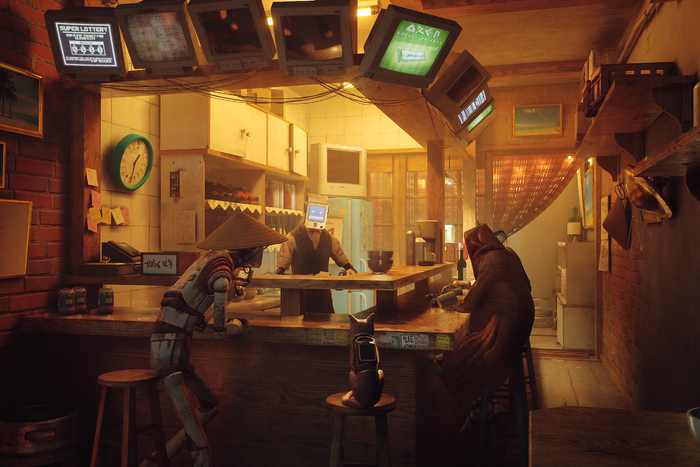
The specter of Kowloon Walled City looms large in the pop culture imagination. The former Hong Kong enclave, with its densely packed buildings, narrow walkways, and gangland self-governance evidently inspired Blade Runner, the slum called the Narrows in Batman Begins, and the claustrophobic streets of Golem City in 2016 video game Deus Ex: Mankind Divided. But have you ever seen it through the eyes of a cat?
This is the tantalizing premise of Stray, the debut video game by Montpellier-based BlueTwelve Studio, published by Annapurna Interactive. You play as a feline protagonist — nimble, curious, playful — transposed in a moment of bad luck to the labyrinthine, futuristic streets of Walled City 99. As a biological creature, your body is at odds with this cybercity and the robotic inhabitants that call it home. This, of course, turns out to be your strength, allowing you to move with a freedom that your mechanized counterparts otherwise lack. For all its apparent hostility, Walled City 99 is a playground, one which sees you bounding from neon sign to gutter pipe and corrugated iron roof — moving like a cat and, in Stray’s most effective moments, thinking like one, too.
The game’s opening moments reinforce this central juxtaposition of nature and technology, all while teaching you how to move with an agility befitting your furry form. With more than a hint of 2012 survival game Tokyo Jungle, a cult hit that imagined animals running wild in an abandoned Tokyo, you traipse through a derelict moss-covered city with your feline friends. A swivel of the left analogue stick dictates direction while the right controls the camera. As you approach a suitable ledge, a button prompt flashes, allowing you to jump gracefully toward it. This is a streamlined, accessible approach to platforming, less reliant on timing and dexterity than that found in the Mario or Tomb Raider franchises, but which intends to make you “feel” more like a cat. You will never fluff a jump in Stray; you are always certain to land on (all four of) your feet.
By foregoing failure for theoretically more seamless roleplaying — Stray is part of a lineage of cinematic games such as Uncharted. There are other, more direct borrowings from Sony’s beloved action-adventure franchise: crawling through tight spaces that act as loading transitions to new areas; beautifully animated moments between non-player characters which punctuate the exploration. Unlike an Uncharted game, however, Stray is non-violent, foregoing all of the murderous action to focus entirely on a quiet kind of exploration.
In line with this focus, Stray’s greatest strength is its sense of place, with environments achieved on a comparatively miniscule budget compared to its blockbuster counterparts. The tightly enclosed alleys and squares are crammed with graffiti, trash, and other artifacts of human habitation. Hermetically sealed from the wider world, the city is illuminated entirely artificially, with the warm hue of lamps and Chinese-looking lanterns or the cold blue of computer screens. In Midtown, shops and apartments tumble on top of one another. In the sewers, a sticky slime coats the concrete. As you move through these exquisitely detailed spaces, a motif symbolizing the robots’ longing for the outside world emerges, showing up on postcards and billboards: a tacky image of a palm tree on an azure-blue beach. Is this how androids dream of paradise?
Despite the dangling carrot of escape, Stray is about experience rather than challenge. There are indeed threats in its world: fleshy tick-like creatures swarm your purring protagonist; drones carry fatal electrical shocks. But these are easily avoided — distractions rather than pulse-quickening moments of genuine conflict. When death does occasionally arrive, it is swift and anticlimactic, a missed opportunity for a game which develops such a sense of kinship between the player and its whiskered lead.
Stray flirts with horror in other ways. There is beautifully unsettling work in the composition of street scenes: Lighting, framing, and props align to evoke undeniably threatening auras. In deep subterranean areas beneath the city, BlueTwelve creates scenes that push into the realm of surrealist body horror — part Dali, part Cronenberg. In early parts of the game, cameras surveil your movements with unnerving persistence. But where a title such as acclaimed 2016 horror-adventure Inside posed similar questions of technology, control, and carnality in its environments before folding them into a cohesive thematic whole, the meatier elements of Stray mostly exist as set-dressing. There’s frustratingly little for players to sink their figurative teeth into beyond the act of exploration itself.
These shortcomings don’t entirely undermine it. The adventure plot, which follows a four act structure, is smartly sculpted and expertly paced, both in its second-to-second action and wider beats. Roleplaying the cat through seemingly meaningless actions such as scratching, drinking, and curling cozily into a ball never fails to warm the heart. Elsewhere, the game’s most comprehensively explored idea stems from the relationship between the cat and B-12, a sweet-natured drone who helps you escape while uncovering the drone’s own bittersweet memories. Strapped to the cat’s back throughout, all the while making bleeping quips, it becomes an indispensable aid. It’s a treat to see the trilling cat and B-12 work together in a fusion of flesh and technology — a cyborg, if you will.
Still, for all the refreshed perspective Stray naturally provides through its feline protagonist, this is a deeply traditionalist vision of cyberpunk that, while handsomely executed, doesn’t quite come alive with its own identity. The seeds of ideas are here, etched into the game’s lavish virtual spaces, but as you pad, leap, and scamp towards them, they don’t quite stand up to scrutiny. Stray ends up feeling a little thin, its narrative and worldbuilding lacking substance that no amount of immaculate rendering can disguise.




